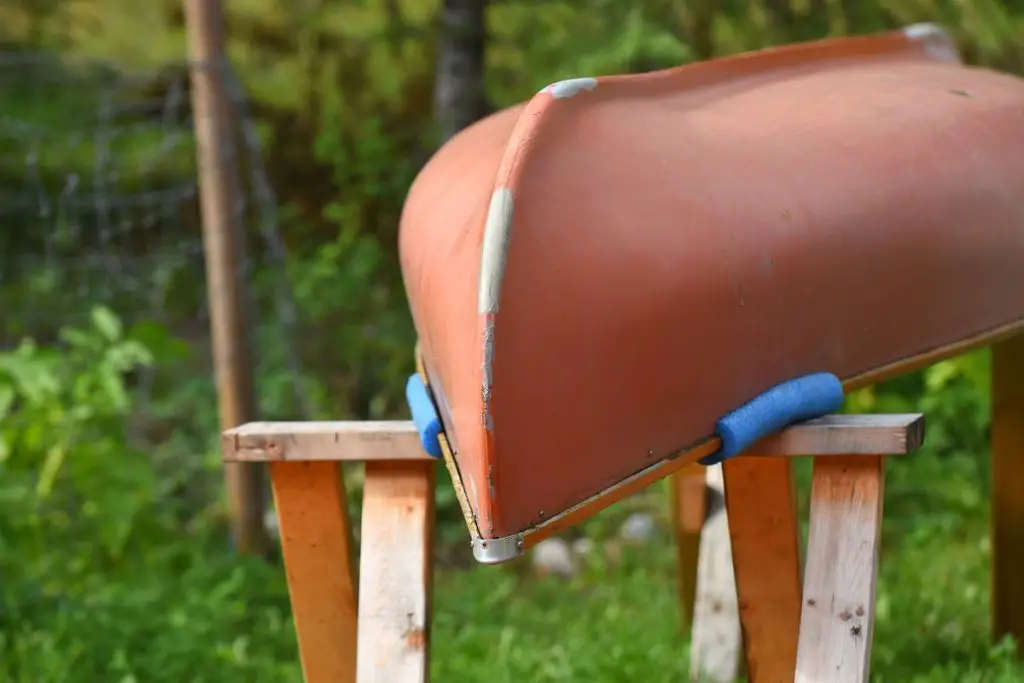To store a kayak is a difficult task, mainly due to the heavy lifting that it requires. These boats also take up a lot of room, making them even harder to store. However, these issues can easily be fixed with a couple of sawhorses.
Kayaks can be safely stored on sawhorses as long as they are padded. Most importantly, you must distribute the weight equally and evenly. Sawhorses are durable and will not cause any damage as long as you use them correctly.
For the rest of this article, I will take you through how you can store a kayak on sawhorses and touch on the safety of using sawhorses for storage. I will also elaborate on the right ways and angles of storing kayaks. Let’s dive into it.

Are Sawhorses Sturdy Enough To Store Kayaks?
When storing your kayak on sawhorses, it is natural to worry about whether this setup will actually hold. Let me put your mind at ease.
Sawhorses are built for support. Their primary purpose is to provide stability during various tasks like sawing and painting.
As a result, they’re made to be quite sturdy. Although they’re usually made of wood, some sawhorses are primarily plastic or metal.
Typically, the sturdiness of your sawhorse will depend on the material and how they’re used.
For wooden sawhorses, the strength heavily depends on the quality of the wood and the type and amount of adhesive used. As for metal sawhorses, any heavy-duty pair could uphold your kayaks without trouble since they can easily carry thousands of pounds.
Their plastic counterparts, however, might not be the best choice to support a kayak.
This is because plastic sawhorses are more suitable for lightweight projects—and if they can barely keep some plywood in place, they are probably not a good option for your kayak.
In short, you can store your kayak on sawhorses if you pay attention to the type you get. Remember, all sawhorses are durable, but their durability is relative to the project.
How To Store a Kayak on Sawhorses
Storing kayaks on sawhorses is efficient for your finances and space. Moreover, it’s an easy process and only takes a few simple steps.
There are a few ways of storing your kayak on sawhorses. Let’s look at them in depth.
Using Two Sawhorses
One of the simplest and most common ways of storing kayaks on sawhorses is to balance them on two sawhorses. Here, one sawhorse goes under each end of the kayak.
You can orient the kayak the right way up or upside-down. The latter is usually the better option since the top of the kayak is much flatter than the bottom, bringing more stability.
Understandably, not everyone is comfortable flipping their boat that way, and that’s perfectly fine! However, if you plan to store it the right way up, keep it balanced by ensuring that each sawhorse is placed at the flattest point of the Kayak so it doesn’t rock easily.
For both methods, keeping the sawhorses roughly equidistant from each end of the kayak is advisable. This allows them to support equal amounts of weight.
Using Four Sawhorses
Another method is to use four sawhorses instead of the traditional two. This follows almost all the same steps as using two sawhorses per kayak. The only difference here is that it uses one more sawhorse at each end of the kayak.
To do this, you should duct tape the added sawhorse to the original one to create a sturdy, one-piece sawhorse. This works best if you have to use plastic sawhorses.
Vertical or Horizontal: What Is the Best Way To Store a Kayak?
There are several ways of storing kayak boats. However, there are also several different types of kayaks, meaning the right storage option for you might not be a suitable method for someone else. This is why I will go over the short-term and long-term storage alternatives for you to decide which is best.
Storing Your Kayak Vertically
Placing your kayak vertically is one of two ways you can store it. But once you put it vertically, you will focus the weight on your boat’s hull.
While this is okay for a day or so, it will eventually damage your kayak.
However, if you are doing this for short-term storage, then make sure to lean your kayak’s boost against a wall to distribute the weight evenly and give your kayak some support.
Storing Your Kayak Horizontally
Keeping your kayak horizontal is a better option for long-term storage as it evenly distributes the weight.
Extra support, like a sawhorse, would be ideal when storing your kayak horizontally. If you place it upside down on the ground, the parts that stick out will have to carry the weight.
This leads to a similar problem to vertical storage, where excessive weight on one part of the kayak will eventually damage it.
Asides from sawhorses, you can also choose to hang your kayak. If you have a large enough wall, you can attach it with straps or, better still, a kayak rack.
The RAD Sportz Kayak Hoist from Amazon is an excellent choice for this. It’s affordable, so you won’t break the bank to get it, but it’s still very durable for the price. It’s also multipurpose and can be used for bikes, canoes, and ladders.
Just avoid placing your kayak on the ground for more than a few days.

Final Thoughts
Kayaks can be difficult to store, but with the right approach, you can work your way around it. Sawhorses are one of the most affordable storage options for kayak boats. Especially if they are made of wood or metal.
If you do not have access to sawhorses, your best storage options would be to either hang your kayak up using straps or place it on the ground with the sidewall facing down to prevent damage.
However, remember that leaving your kayak on the ground should never be a long-term option.
Sources
- Thrift Diving: Everything You Wanted to Know About Sawhorses: A Guide
- Old Town Canoe: The Ultimate Kayak Storage Guide
- YouTube: Easy, Strong Sawhorses
- Lowe’s: Steel Sawhorses at Lowe’s.com
- Bob Vila: The Best Sawhorses of 2022
- Paddle About: How to Store a Kayak the Right Way
- Paddling Magazine: 7 Simple, Space-Saving Ways to Store Your Kayak
- Paddling: Sawhorse Kayak Storage Question
- N.C. Angler: Kayak Storage Question
- How to Properly Store & Protect Your Kayak
- Life Storage: How to Store a Kayak Without Damaging the Hull
- Reel Pursuits: How to Store a Kayak: 5 Things You Should Know
